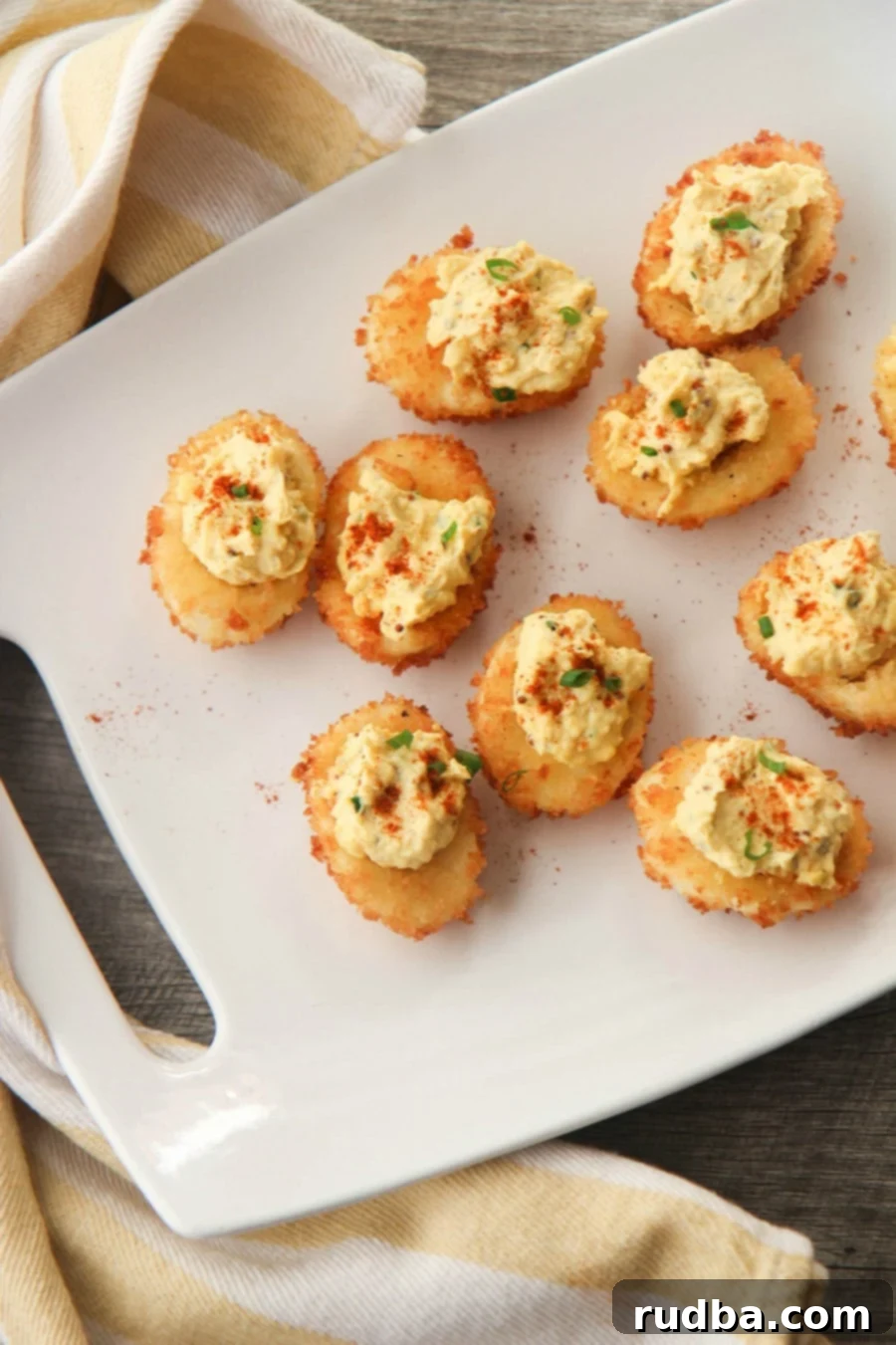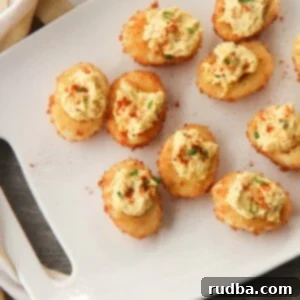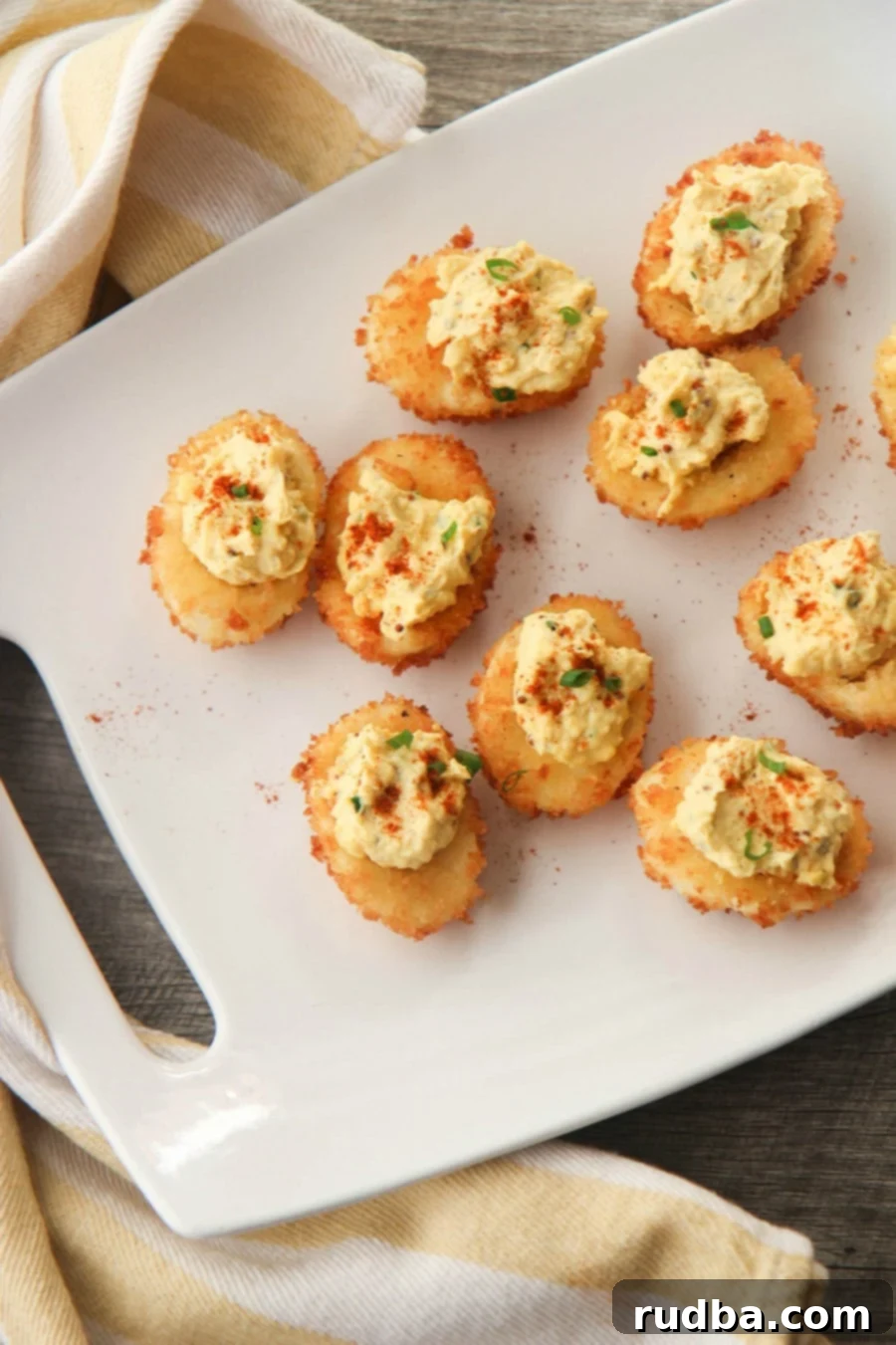Crispy Fried Deviled Eggs: The Ultimate Appetizer Recipe Guide
Are you ready to take a classic appetizer and transform it into something truly extraordinary? Say goodbye to your grandma’s traditional deviled eggs and prepare for a culinary revelation! These deep-fried deviled eggs aren’t just an upgrade; they’re a complete game-changer. Imagine a perfectly golden-brown, super crispy exterior giving way to a rich, tender egg white, filled with an incredibly creamy and savory yolk mixture. This recipe, made with just a handful of simple ingredients, is poised to become your new favorite holiday appetizer, party snack, or any-time indulgence.

Want to add an extra level of excitement to your classic deviled eggs? The secret lies in frying them! This innovative technique doesn’t just make your eggs look impressive; it gives them an added depth of flavor and an irresistible texture that will make the spiced filling truly sing. While these fried deviled eggs are always a hit as an appetizer, their versatility means you can easily serve them as a unique side dish for brunch or a delightful snack any time of day. They are surprisingly easy to make and guaranteed to be incredibly crunchy and delicious, leaving a lasting impression on anyone who tries them.
Why Fry Your Deviled Eggs? A Texture and Flavor Sensation
You might be thinking, “Why mess with a classic?” The answer is simple: to unlock a whole new dimension of culinary delight. Frying deviled eggs elevates them from a simple, creamy bite to a multi-textured masterpiece. The outer layer, typically achieved with a perfect panko breading, crisps up beautifully in hot oil, creating a satisfying crunch that contrasts magnificently with the tender egg white and the smooth, rich yolk filling. This isn’t just about adding a crispy shell; it’s about enhancing the entire experience.
- Unforgettable Texture: The juxtaposition of the crunchy coating and the soft interior is truly unique and addictive.
- Enhanced Flavor: Frying adds a subtle toasted, nutty flavor to the egg white that complements the creamy yolk mixture perfectly. The hot oil helps to deepen the savory notes.
- Impressive Presentation: Fried deviled eggs look gourmet and sophisticated, making them an ideal showstopper for any gathering, from casual parties to elegant holiday dinners.
- A Delightful Surprise: Guests will be intrigued by this unexpected twist on a beloved favorite, making your dish a memorable talking point.
- Perfect for Any Occasion: While they shine during holidays, these can be served at BBQs, potlucks, or even as a decadent brunch item.
The Origins of Deviled Eggs and Their Modern Evolution
The concept of stuffed eggs dates back to ancient Rome, where recipes for boiled eggs seasoned with spices and sauces were common. The “deviled” term itself appeared in the 18th century and referred to dishes that were highly seasoned or spicy. By the 19th century, deviled eggs, particularly in the American South, became a staple for picnics, potlucks, and family gatherings. The classic recipe typically involves halving hard-boiled eggs, scooping out the yolks, mixing them with mayonnaise, mustard, and spices, then piping the mixture back into the whites.
Over the decades, home cooks and chefs have experimented with countless variations, adding everything from bacon to relish to herbs. Frying deviled eggs is a relatively modern innovation, a testament to our continuous desire to innovate and bring new life to cherished traditions. It takes the familiar comfort of a deviled egg and infuses it with the exciting crispness of a fried appetizer, creating a dish that respects its roots while boldly stepping into contemporary cuisine.
How Do You Make Fried Deviled Eggs? A Step-by-Step Guide
Creating these crispy delights is easier than you might think. The process is broken down into simple steps, ensuring perfect results every time. Here’s a detailed look at how to achieve deviled egg perfection:
1. Prepare Your Hard-Boiled Eggs
Start off by boiling the eggs. For best results, place your eggs in a saucepan and cover them with about an inch of cold water. Bring the water to a rolling boil, then immediately turn off the heat, cover the pan, and let the eggs sit for 10-12 minutes (for firm yolks) or 6-8 minutes (for slightly softer yolks, as preferred in this recipe). After cooking, drain the hot water and immediately transfer the eggs to an ice bath for at least 5 minutes. This stops the cooking process and helps with easier peeling. Once cooled, peel them carefully to avoid any damage to the whites. Slice them in half lengthwise and gently scoop out the yolks into a small bowl, keeping the egg whites intact.
2. Create the Creamy Yolk Filling
In the bowl with the yolks, add your mayonnaise, Dijon mustard, grain mustard, vinegar, hot sauce, and finely chopped chives. Season generously with salt and black pepper to taste. Using a fork or a potato masher, thoroughly mash the yolks and mix all the ingredients until the mixture is completely smooth and creamy. Taste and adjust seasonings as needed. This filling should be vibrant and flavorful, as it’s the heart of your deviled egg.
3. Master the Dredging Process
This is where the magic happens for that incredible crunch. Set up a three-station dredging line:
- Flour Station: Place all-purpose flour in a shallow dish.
- Egg Wash Station: In another shallow dish, whisk 2 eggs for dipping.
- Panko Breadcrumbs Station: In a third shallow dish, place your panko breadcrumbs. For extra flavor, season your panko breadcrumbs with a pinch of salt and pepper before you start.
Take each egg white half and first coat it thoroughly in the all-purpose flour, ensuring both sides are evenly covered. Gently shake off any excess flour. Next, dip the floured egg white into the beaten egg, allowing any excess to drip off. Finally, press the egg white into the seasoned panko breadcrumbs, ensuring a generous and even coating on both sides. Repeat this process for all the egg white halves.
4. Fry to Golden Perfection
Heat about 1-2 inches of high smoke point oil (like vegetable, canola, or peanut oil) in a heavy-bottomed skillet or a Dutch oven over medium-high heat. The oil should reach a temperature between 350-375°F (175-190°C). Once the oil is hot, carefully place the breaded egg whites into the skillet, ensuring not to overcrowd the pan. Fry the eggs for just 20-30 seconds on each side, or until they turn a beautiful golden brown and are crispy. Use tongs or a slotted spoon to carefully remove the fried egg whites and immediately place them on a paper towel-lined plate to drain any excess oil. Working in batches will help maintain the oil temperature and ensure even cooking.
5. Fill and Garnish
Once all the egg whites are fried and drained, it’s time to fill them. You can use a spoon to dollop the yolk mixture into each fried egg white, or for a more elegant presentation, pipe the filling using a pastry bag with a star tip. Finally, garnish your fried deviled eggs with a sprinkle of paprika, fresh chopped chives, or scallions, if desired. Serve immediately and watch them disappear!

Achieving the Perfect Fry: Oil Temperature and Type
The success of your crispy fried deviled eggs hinges on maintaining the correct oil temperature. As mentioned in the recipe, the ideal range is between 350-375 degrees Fahrenheit (175-190°C). Why is this so crucial?
- If the oil is too hot: The breading will burn quickly, turning dark brown or black before the egg white has a chance to heat through properly. You’ll end up with a bitter, burnt exterior and potentially cold interior.
- If the oil is not hot enough: The egg whites will absorb too much oil, resulting in a greasy, soggy, and unappetizing coating. They won’t achieve that coveted golden crispness.
For best results and safety, always use a thermometer to monitor your oil temperature. A candy thermometer or a deep-fry thermometer works perfectly. As for the type of oil, choose one with a high smoke point. Good options include:
- Vegetable Oil
- Canola Oil
- Peanut Oil
- Sunflower Oil
These oils can withstand high heat without breaking down, ensuring a clean flavor and perfect crispness for your fried deviled eggs. Avoid olive oil or butter for deep frying, as they have lower smoke points and will burn easily.
Panko vs. Regular Breadcrumbs: What’s the Difference?
While the original recipe states you can use any breadcrumbs you have on hand, there’s a good reason why panko is specifically recommended for this dish to achieve truly crispy deviled eggs. Panko breadcrumbs are a Japanese-style breadcrumb, and they differ significantly from traditional Italian or fine breadcrumbs:
- Flake Size and Shape: Panko has a larger, airier, and more irregular flake structure compared to the fine, dense crumbs of regular breadcrumbs. This allows for a lighter and crispier coating.
- Absorbs Less Oil: Due to their airy texture, panko crumbs absorb less oil during frying, resulting in a less greasy and crunchier finish. Regular breadcrumbs tend to soak up more oil, leading to a heavier, sometimes chewier texture.
- Stays Crispier Longer: Panko coatings tend to stay crispy for a longer period, which is great if you’re serving these as an appetizer at a party.
So, while you *can* use regular breadcrumbs, understand that the texture won’t be quite the same. If using regular breadcrumbs, you might consider toasting them lightly in a dry pan for a few minutes before use to enhance their flavor and help them crisp up a bit more. However, for that ultimate, airy, and super crunchy deviled egg experience, panko is undeniably the superior choice.
Expert Tips for Fried Deviled Egg Success
To ensure your fried deviled eggs are always a triumph, keep these tips in mind:
- Choose the Right Eggs: While fresh eggs are great for eating, eggs that are a week or two old are generally easier to peel when hard-boiled.
- Perfect Hard-Boiling: Don’t skip the ice bath! Rapidly cooling the eggs after boiling helps prevent a green ring around the yolk and makes peeling much smoother, minimizing damage to the whites.
- Smooth Yolk Mixture: Ensure your yolk mixture is completely smooth. Any lumps will make piping or spooning difficult and affect the creamy texture.
- Dredging Technique: When coating the egg whites, ensure each step is thorough. The flour helps the egg wash adhere, and the egg wash helps the panko stick. A good coating is key to a crispy exterior.
- Don’t Overcrowd the Pan: Fry in small batches to maintain the oil’s temperature. Overcrowding will lower the oil temperature, leading to greasy eggs.
- Drain Excess Oil: Always place fried eggs on a paper towel-lined plate or a wire rack set over paper towels immediately after removing them from the oil. This absorbs excess oil and keeps them crisp.
- Make Ahead Tips: You can hard-boil and peel the eggs a day in advance. Store the whites and yolks separately in airtight containers in the refrigerator. The yolk mixture can also be made ahead and stored. Fry the whites and fill just before serving for the best texture.
- Serving Temperature: Fried deviled eggs are best served warm or at room temperature, shortly after they are assembled.
Creative Variations and Flavor Combinations
While the classic fried deviled egg recipe is fantastic on its own, don’t hesitate to get creative with your yolk mixture filling and garnishes to customize it to your taste or match a specific occasion:
- Smoky & Savory: Add finely crumbled crispy bacon bits or smoked paprika to the yolk mixture. Top with more bacon or a sprinkle of chipotle powder.
- Seafood Delight: Fold in some finely chopped cooked crab meat, shrimp, or even smoked salmon into the yolk mixture for a luxurious touch.
- Avocado Creaminess: For a twist, mash in some ripe avocado with the yolks. A squeeze of lime juice will keep it fresh and bright.
- Herbaceous Freshness: Experiment with different fresh herbs like dill, parsley, or cilantro, finely chopped and mixed into the filling.
- Cheesy Goodness: Stir in a tablespoon of finely grated Parmesan cheese or sharp cheddar into the yolk mixture for an extra layer of umami.
- Spicy Kick: If you love heat, increase the hot sauce, or add a pinch of cayenne pepper or finely diced jalapeños (ensure they are very fine to maintain a smooth texture).
- Gourmet Touch: A tiny drizzle of truffle oil or a sprinkle of high-quality sea salt flakes can elevate your deviled eggs to an even more refined level.
- Holiday Colors: For festive occasions, you can even add a tiny drop of food coloring to the yolk mixture to create vibrant hues for Easter, Christmas, or Halloween parties.
Serving Suggestions and Presentation Ideas
Fried deviled eggs are incredibly versatile. Here are a few ideas for how to serve them:
- Classic Appetizer: Arrange them on a beautiful platter, garnished with fresh chives, a dusting of paprika, or a few delicate sprigs of dill.
- Brunch Star: Serve alongside other brunch favorites like quiches, fruit salads, and mimosas.
- Party Snack: Perfect for game day, potlucks, or any gathering where finger foods are appreciated.
- Mini Side Dish: They can accompany grilled meats or sandwiches as a fancy alternative to potato salad.
For an extra touch, consider a variety of garnishes beyond paprika and chives: crispy fried shallots, a tiny dollop of caviar for a luxurious twist, a sprinkle of everything bagel seasoning, or even a microgreen for color.
More Recipes You’ll Enjoy:
- Southern Fried Shrimp
- Baked Buffalo Wings
- Veggie Bars
- Cheese Stuffed Mushrooms

Fried Deviled Eggs
Save RecipeSaved Recipe
Pin Recipe
Rate Recipe
Print Recipe
Ingredients
- 6 eggs
- 1/4 cup mayonnaise
- 1/2 tbsp dijon mustard
- 1/2 tbsp grain mustard
- 1/4 tsp vinegar
- 1 tsp hot sauce
- 1 tsp chives
- salt and pepper to taste
- 1 cup panko bread crumbs
- 1/2 cup all purpose flour
- 2 eggs, for dipping
Instructions
-
Place eggs in a saucepan and cover with water.
-
Once the water comes up to a boil let the eggs cook for an additional 6 minutes.
-
Remove from heat, rinse with cold water, and remove the shells.
-
Slice the eggs in half lengthwise, remove the yolks and then place the yolks into a small bowl.
-
Add the mayo, vinegar, grain mustard, dijon mustard, hot sauce, chives, salt, and pepper to the yolks and mix until well combined.
-
Season the breadcrumbs with salt and pepper.
-
Coat the egg whites in all-purpose flour, evenly coating on both sides.
-
Dip the flour coated egg whites in the beaten eggs, then press them into the bread crumbs on both sides.
-
Repeat for each egg white.
-
Fry the egg whites for 20-30 seconds or until golden brown.
-
Evenly disperse the yolk mixture into each fried egg.
-
Sprinkle some paprika and chives on top if desired and enjoy!
Video
Notes
- Get creative with the yolk mixture filling and add crispy bacon, crab meat, smashed avocados, etc.
- Feel free to add food coloring to the eggs during the holidays.
Nutrition
Nutrition information is automatically calculated, so should only be used as an approximation.
Additional Info
Like this recipe? Leave a comment below!
Conclusion: Your New Go-To Appetizer
Once you give these fried deviled eggs a try, you’ll understand why they’re quickly becoming a sensation. The addictive crunch, the creamy filling, and the elevated flavor profile make them far superior to their traditional counterparts. Classic deviled eggs will truly never be the same again. This recipe is not just a dish; it’s an experience that combines comfort food with an exciting, unexpected twist.
Whether you’re hosting a holiday feast, a casual get-together, or simply looking for a delicious snack, these crispy deviled eggs are guaranteed to impress. They’re surprisingly simple to make, yet yield a gourmet result that will have everyone asking for the recipe. So go ahead, get frying, and prepare to delight your taste buds and your guests. Make sure to share this incredible fried deviled eggs recipe with your family and friends – they’ll thank you for introducing them to this delicious innovation!
